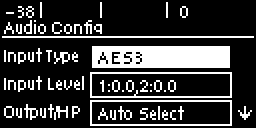
If your input source is AES3 (AES/EBU) format use the IN1/AES3 IN input on the rear panel of the codec. This is a balanced 110 ohm female XLR input and can operate effectively over distances of up to 100 meters. The input accepts both mono and stereo AES3 signals as only a single 3 pin XLR input or output is required for sending and receiving two channels of AES3 data. To configure the codec to accept AES3 data signals:
1.Press the SETTINGS  button.
button.
2.Navigate to Audio and press  .
.
3.Select Input Type and press the  button to toggle from Analog to AES/EBU.
button to toggle from Analog to AES/EBU.

The 3 pin male XLR AES3 output on the rear panel is labeled AES3 OUT. It is capable of sending both mono and stereo AES3 signals.
|
Important Note: Input attenuation is available when the input type is AES digital, however there is no additional gain. If you switch back to the analog input setting after selecting AES3, the previous analog settings will be recovered. |
AES/EBU Sample Rate Conversion
The codec implements an Asynchronous Sample Rate Converter (ASRC) to convert the sample rate of the AES3 input to the sample rate set in the codec. The codec sample rate is determined by the selected algorithm. For example, if you select the Music algorithm, the sample rate will be set to 32kHz when the codec is connected.
The codec accepts AES3 input sample rates of 32kHz, 44.1kHz or 48kHz. The output sample rate is determined by the algorithm used when connected.
AES3 Audio Out & SD Card Sample Rate
1.When you are not connected, you can adjust the AES3 output sample rate manually in the Audio menu via the AES3 SR setting.
2.If file playback occurs before a connection is initiated, the AES3 output sample rate will match the audio file sample rate.
3.For best performance, the SD card file sample rate should match the AES3 SR setting in the codec and the algorithm sample rate. If they don't match, the codec will re-sample the SD card file audio to match the connection sample rate, and this will be used by the AES3 output. For example, if you are streaming audio using Tieline Music (32kHz sampling), file playback will be re-sampled to 32kHz if the SD card file is 44.1kHz or 48kHz. In this example the AES3 output sample rate will be 32kHz.
Adjusting the Codec Output Sample Rate
As there is no external reference clock for the codec it is necessary to set the output sample rate of the codec when you are not connected. The AES3 SR setting in the Audio menu will configure audio outputs and audio monitoring, as well as SD card playback at this sample rate. The default setting is 48kHz sampling:
1.Press the SETTINGS  button.
button.
2.Navigate to Audio and press  .
.
3.Navigate to AES3 SR and press  .
.
4.Select a preferred sample rate then press  .
.
Tieline normally recommends selecting STL Silence Mode for audio monitoring if using AES3. If using Auto Select make sure the algorithm sample rate and the AES3 SR sample rate setting are the same.

